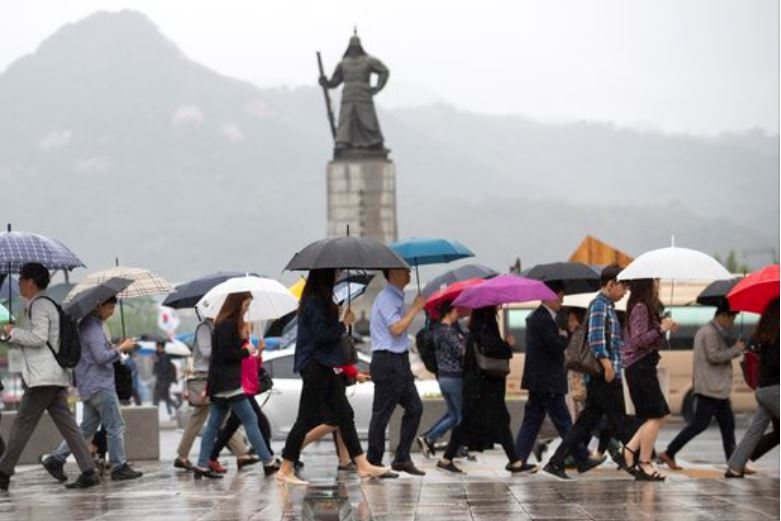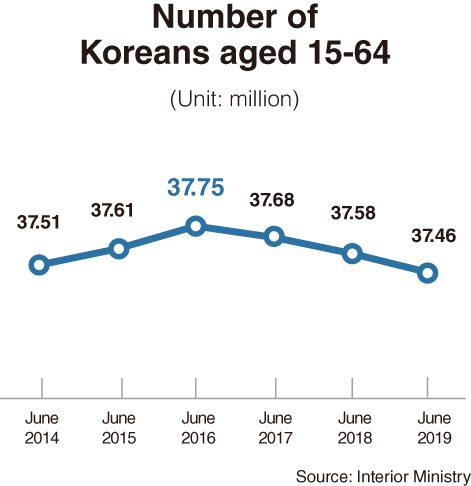[News Focus] Working-age population falls to 2013 level
By Kim Yon-sePublished : July 9, 2019 - 16:33
SEJONG -- South Koreans have expressed significant fears about the nation’s workforce and growth potential in the coming decades, and it appears that recent demographic changes lend weight to those concerns.
Two or three years ago, people aged between 15 and 64 began declining in number after a long period of continuous growth.
People in this age group are classified as members of the working-age population, according to Organization for Economic Cooperation and Development criteria. At present, this group comprises people born approximately between 1955 and 2004.
Two or three years ago, people aged between 15 and 64 began declining in number after a long period of continuous growth.
People in this age group are classified as members of the working-age population, according to Organization for Economic Cooperation and Development criteria. At present, this group comprises people born approximately between 1955 and 2004.

According to the Ministry of Interior and Safety, Korea’s working-age population peaked at 37.786 million in November 2016.
Since December 2016, that figure has dropped consistently. As of June 2019 it stood at 37.464 million, having declined for the 31st consecutive month. That amounts to 322,000 fewer people in less than three years.
In addition, the last month’s figure marked the lowest in 66 months, since December 2013, when the number of people aged 15-64 posted 37.457 million.
The trend is inversely proportional to the nation’s overall population growth, which means the working-age population is shrinking in proportion to the population as a whole.
“The drop in recent years is critical as the baby boomer generation, born between 1955 and 1963, still belongs to the working-age population,” said a government official at Government Complex Sejong.
In line with the warnings of many private researchers, the official predicted a steeper decline beginning next year, when those born in 1955 are classified as seniors -- both in terms of numbers and in proportion to the population as a whole.
Some local research analysts have begun using the term “demographic cliff,” first made popular by US economist Harry Dent.
An analyst in Seoul used that term -- citing the economist's theory -- in the context of a possible economic crisis caused by a rapid drop in the number of people aged between 45 and 49, who account for a great deal of private consumption.
Currently, those born around 1970 are aged in their mid- to late 40s or early 50s, and are known in Korea as “the second generation of baby boomers.” As this generation ages in the coming decade, the percentage of people in their 40s -- the backbone of the nation’s industries -- will sharply decline.
The LG Economic Research Institute, in a report, forecast that the rapid decline of the working-age population would pull down the nation’s potential growth rate to 1.9 percent between 2020 and 2024.
The shrinking workforce will slash GDP growth by 0.4 percentage point between 2020 and 2024, and by 0.5 percentage point between 2025 and 2029.
Interior Ministry data showed that the percentage of those aged 15-64 stood at 72.2 percent in June 2019, a 1 percentage point drop from December 2013.

Statistics Korea estimates that people aged 15-64 will fall below 70 percent of the population within five years to 69.9 percent in 2024. The state-run agency also predicted that this figure would post less than 60 percent in 2036 and less than 50 percent in 2056.
Further, projections indicate that the senior population will overtake the working-age population, relative to the total population, in 2065, when working-age people will comprise 45.9 percent of the total and seniors 46.1 percent.
Meanwhile, Interior Ministry data showed that the number of children aged 0-9 posted 4.23 million as of June 2019 -- putting this age group at the bottom of the rankings among age groups under 70, amid record-low fertility rates.
Those in their 50s topped the list with 8.67 million, trailed by those in their 40s with 8.47 million, those in their 30 with 7.17 million and those in their 20s with 6.82 million.
Those aged 60-69 outnumbered people aged 10-19 by 6.12 million versus 5.04 million.
In this aged society, the number of Koreans aged 70-79 reached an all-time high of 3.54 million. Those in their 80s and 90s, as well as centenarians, also posted record numbers.
By Kim Yon-se (kys@heraldcorp.com)


![[Exclusive] Korean military set to ban iPhones over 'security' concerns](http://res.heraldm.com/phpwas/restmb_idxmake.php?idx=644&simg=/content/image/2024/04/23/20240423050599_0.jpg&u=20240423183955)




![[Herald Interview] 'Amid aging population, Korea to invite more young professionals from overseas'](http://res.heraldm.com/phpwas/restmb_idxmake.php?idx=644&simg=/content/image/2024/04/24/20240424050844_0.jpg&u=20240424200058)
![[Pressure points] Leggings in public: Fashion statement or social faux pas?](http://res.heraldm.com/phpwas/restmb_idxmake.php?idx=644&simg=/content/image/2024/04/23/20240423050669_0.jpg&u=)









